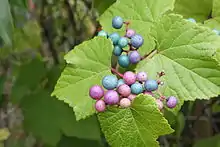Ampelopsis glandulosa var. brevipedunculata
Ampelopsis glandulosa var. brevipedunculata, with common names creeper, porcelain berry, Amur peppervine, and wild grape, is an ornamental plant, native to temperate areas of Asia.[2] It is generally similar to, and potentially confused with, grape species (genus Vitis) and other Ampelopsis species.[3]
| Ampelopsis glandulosa var. brevipedunculata | |
|---|---|
 | |
| Scientific classification | |
| Kingdom: | Plantae |
| Clade: | Tracheophytes |
| Clade: | Angiosperms |
| Clade: | Eudicots |
| Clade: | Rosids |
| Order: | Vitales |
| Family: | Vitaceae |
| Genus: | Ampelopsis |
| Species: | |
| Variety: | A. g. var. brevipedunculata |
| Trinomial name | |
| Ampelopsis glandulosa var. brevipedunculata (Maxim.) Momiy. | |
| Synonyms[1] | |
| |
Description


Ampelopsis glandulosa is a deciduous, woody, perennial climbing vine with flowers and tendrils opposite the palmately lobed leaves, which have 3 to 5 more or less deep lobes and crenellated margins (with a small apicle). The leaves are white-shiny underneath with a coarsely toothed margin. Porcelain berry climbs via tendrils to a height of 4-6m (15-20 ft). The tendrils cling to the supports by non-adhesive tendrils (like Vitis) and differently from the Parthenocissus genus which have adhesive balls). The tendrils are opposite the leaves and have 2 or 3 branches.
The inflorescence is a corymbiform cyme, attached opposite a leaf. Flowers are small, green-white, born in umbels opposite the leaves, and appear in June through August. Fruits are 4-8mm in diameter, circular, containing 2-4 seeds, and may be many colors including green, blue, purple, pink or yellow with black or brown speckles; many different colors are present on the same plant. The berries are produced in late summer and fall. The seeds are dispersed by birds.
Porcelain berry can be confused with native grapes based on leaf shape but can be differentiated by cutting the stem and observing the pith. Grapes have brown or tan pith but porcelain berry has white pith.[4]
Distribution
It grows in forests where it clings to trees and shrubs. It is found in Northeast China (Heilongjiang, Jilin, Liaoning), Korea, Siberia and Japan. It was introduced in 1870 to the United States where it became invasive in 13 states in the Northeast (from New Hampshire to Georgia). Its very rapid growth makes it difficult to control.
Cultivation
Ampelopsis glandulosa var. brevipedunculata has distinctive medium blue fruit, and is an ornamental plant used in gardens to garnish the walls and arbours. Porcelain berry is still widely cultivated despite knowledge of its invasiveness. That being said, if not properly managed it will become dominant on, and kill, many smaller trees. It will climb larger trees to the top.
The variety A. brevipedunculata 'Elegans' is less vigorous than the type species. It has smaller leaves, mottled in white and pink, and it is more sensitive to frost. Porcelain berry often co-exists with Virginia Creeper, Poison Ivy and Sassafras.[4]
Conservation
It is a major invasive plant species in parts of the Eastern United States.[5] It is invasive in urban settings as well as in more pastoral settings.[5] Porcelain berry is often found in disturbed areas such as roadsides, old fields, and floodplains where sunlight is abundant[6] Birds consume the seeds of porcelain berry and act as a vector to transport it.[4] See Zoochory.
Chemistry
The unusual blue color of the berries is due to an anthocyanidins-flavonols copigmentation phenomenon.[7]
Ampelopsin A, B and C are stilbene oligomers found in A. glandulosa var hancei (formerly A. brevipedunculata var. hancei.[8]
References
| Wikimedia Commons has media related to Ampelopsis glandulosa var. brevipedunculata. |
- The Plant List: A Working List of All Plant Species, retrieved 7 February 2016
- Swearingen, Jil, B. Slattery, K. Rehetiloff, and S. Zwicker. 2010. Plant Invaders of the Mid-Atlantic Natural Areas. 4th Edition. National Park Service and the U.S. Fish and Wildlife Service, Washington, D.C. 168 pp.
- "Porcelainberry". PCA Alien Plant Working Group's least wanted.
- "Porcelainberry". US National Park Service. Retrieved 1 November 2015. When the fruit/seeds are developing, honey bees and other pollinators will excitedly visit every cluster. Research on this as a nectar source has not been found.
- "Porcelainberry". Plant Invaders of Mid-Atlantic Natural Areas.
- Rhoads, Block (2007-09-05). The Plants of Pennsylvania (2 ed.). ISBN 978-0-8122-4003-0.
- Effect of anthocyanin, flavonol co-pigmentation and pH on the color of the berries of Ampelopsis brevipedunculata. Yoshitama K., Ishikura N., Fuleki T. and Nakamura S., Journal of plant physiology, 1992, vol. 139, no5, pp. 513-518
- Yoshiteru Oshima, Yuji Ueno and Hiroshi Hikino. Ampelopsins A, B and C, new oligostilbenes of Ampelopsis brevipedunculata var hancei, Tetrahedron, volume 45, Issue 15, 1990, pp. 5121-5126, doi:10.1016/S0040-4020(01)87819-4
- Pink, A. (2004). Gardening for the Million. Project Gutenberg Literary Archive Foundation.